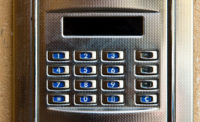Both Skidmore College and the Miami-Dade Aviation Department face unique requirements for their access control systems. Skidmore is a small, highly selective, private liberal arts college in Saratoga Springs, New York, located on an 800-acre campus. The vast size of the school makes managing keys and credentials a daunting annual task.
In Miami-Dade County, three airports of varying security requirements make Ray Davalos’ job as Automation Systems Manager even more complicated as he manages the security systems at Miami International Airport, the Opa-locka Executive Airport and the Kendall-Tamiami Executive Airport, which has the most aircraft operations of the county’s four General Aviation (GA) airports and is open 24/7.
Each of these facilities’ access systems have to meet specific requests – some more difficult to accommodate than others.
At Skidmore College, the entire campus used to be locked via physical keys. When college administrators decided to switch to card-driven access control, there were many hurdles that would need to be cleared. The sheer size of the campus was one thing, and officials needed a way to ensure that even the school-owned apartment complexes on the edges of campus would be accounted for and reliable. The residential facilities’ access control couldn’t be affected by power outages, and they would have to be adaptable for many student situations, including temporary residents such as summer welcome classes.
Working with Ingersoll Rand to provide new keycard security systems, the college is converting key locks to card access on all new buildings, as well as retrofitting existing residence halls. Most exterior doors are already converted, and interior door upgrades are underway. Over the next two years, all of the residential units will be retrofitted.
“This technology is more efficient in eliminating the need for students to carry additional keys and removes the need to re-key doors throughout the entire college year as residence needs change,” says Dennis Conway, Director of Campus Safety. “The use of card access also cuts down on the need for security personnel to respond to lockouts and enables his staff to focus on its primary security function.”
By integrating all card functions into a single system – including student identification and food or book purchases – the one-card access control system adds value all over campus, regardless of the distance from the main facilities.
Distance and isolation proves to be more of an issue for Davalos, who worked with Matrix Systems to integrate access control at two of the major airports with magstripe card readers over V-LANs. However, at the most remote of the three facilities, the only connectivity is via satellite communication.
“With technology, most systems can be tied together with data-sharing connectivity,” Davalos says. “But that airport was a challenge. Satellite communications is very latent for CCTV, but that’s what we have available there for our security systems.”
The airport only allows entry with ID verification and video surveillance, which is monitored locally and from the main airport.
“We’re always looking to improve, but we have to wait for grants,” Davalos says. “Especially for smaller airports, those are harder to come by. So we secure in layers, starting with the most important needs.”
However, Davalos’ biggest lesson during his 24 years with the Aviation Department is the difference in culture between a major international airport and general aviation: “General aviation can be leery of access restriction, and we get some push-back,” he says. “At the major airports, you tell everyone what the required measures are, and they’re easier to convince. In general aviation, you’re working with the owner directly to try to go above and beyond the minimum security requirements of a GA airport.
“Education plays a big part of it, especially in the remote locations. You go in to explain the new projects and try to get buy-in. New measures might cost extra time and money for Mom-and-Pop operations, and some people might not pass new security clearance requirements, but they’re improvements overall,” Davalos adds.
All-in-all, the system is organized in Miami-Dade County to increase efficiency and lower the need for frequent on-site visits to each access point. The security measures are all monitored from one system with all historical, embedded data in a central data base. Our next goal (layer) is a Centralized Command Center, which houses first responders, emergency response teams, “All the main decision-makers,” Davalos says. “It’s a unified command post, so we can make informed decisions without having to track people down across facilities.”
At Skidmore College, too, records are all kept in a uniform, consolidated system. While residential card readers are run as offline locks so they aren’t affected by power outages, the rest of the campus – including newly converted academic buildings such as the Arthur Zankel Music Center – uses online locks that send data directly into the system. The offline locks’ data and audit trails are downloaded onto a PDA and then uploaded into the system.
The flexibility of the card system at Skidmore helps to accommodate changing users, especially when outside groups conduct summer programs, and the campus may be used by 3,000 to 5,000 people. The college wanted a credential that functions similar to a hotel card, where the next card bumps the last one out of the lock – reducing the needs for re-keying thousands of locks every semester and re-issuing credentials, which saves time and money for students, faculty and staff.





